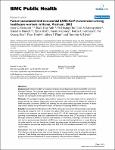Factors associated with nosocomial SARS-CoV transmission among healthcare workers in Hanoi, Vietnam, 2003
Reynolds, Mary G
Anh, Bach Huy
Thu, Vu Hoang
Montgomery, Joel M
Bausch, Daniel G
Shah, J Jina
Maloney, Susan
Leitmeyer, Katrin
Huy, Vu Quang
Horby, Peter
Plant, Aileen J
Uyeki, Timothy M
Background: In March of 2003, an outbreak of Severe Acute Respiratory Syndrome (SARS) occurred in Northern Vietnam. This outbreak began when a traveler arriving from Hong Kong sought medical care at a small hospital (Hospital A) in Hanoi, initiating a serious and substantial transmission event within the hospital, and subsequent limited spread within the community. Methods: We surveyed Hospital A personnel for exposure to the index patient and for symptoms of disease during the outbreak. Additionally, serum specimens were collected and assayed for antibody to SARS-associated coronavirus (SARS-CoV) antibody and job-specific attack rates were calculated. A nested case-control analysis was performed to assess risk factors for acquiring SARS-CoV infection. Results: One hundred and fifty-three of 193 (79.3%) clinical and non-clinical staff consented to participate. Excluding job categories with < 3 workers, the highest SARS attack rates occurred among nurses who worked in the outpatient and inpatient general wards (57.1, 47.4%, respectively). Nurses assigned to the operating room/intensive care unit, experienced the lowest attack rates (7.1%) among all clinical staff. Serologic evidence of SARS-CoV infection was detected in 4 individuals, including 2 non-clinical workers, who had not previously been identified as SARS cases; none reported having had fever or cough. Entering the index patient's room and having seen (viewed) the patient were the behaviors associated with highest risk for infection by univariate analysis (odds ratios 20.0, 14.0; 95% confidence intervals 4.1-97.1, 3.6-55.3, respectively). Conclusion: This study highlights job categories and activities associated with increased risk for SARS-CoV infection and demonstrates that a broad diversity of hospital workers may be vulnerable during an outbreak. These findings may help guide recommendations for the protection of vulnerable occupational groups and may have implications for other respiratory infections such as influenza.
No license information

